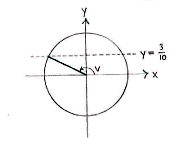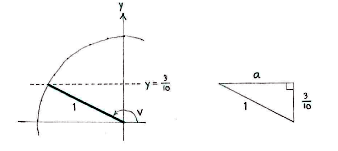Solution 4.3:6b
From Förberedande kurs i matematik 1
We draw an angle \displaystyle v in the unit circle, and the fact that \displaystyle \text{sin }v\text{ }=\frac{3}{10} means that its \displaystyle y -coordinate equals \displaystyle \frac{3}{10}.
With the information that is given, we can define a right-angled triangle in the second quadrant which has a hypotenuse of \displaystyle \text{1} and a vertical side of length \displaystyle \frac{3}{10}.
We can determine the triangle's remaining side by using Pythagoras' theorem,
\displaystyle a^{2}+\left( \frac{3}{10} \right)^{2}=1^{2}
which gives that
\displaystyle a=\sqrt{1-\left( \frac{3}{10} \right)^{2}}=\sqrt{1-\frac{9}{100}}=\sqrt{\frac{91}{100}}=\frac{\sqrt{91}}{10}
This means that the angle's \displaystyle x -coordinate is \displaystyle -a, i.e. we have
\displaystyle \cos v=-\frac{\sqrt{91}}{10}
and thus
\displaystyle \tan v=\frac{\sin v}{\cos v}=\frac{\frac{3}{10}}{-\frac{\sqrt{91}}{10}}=-\frac{3}{\sqrt{91}}


